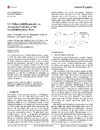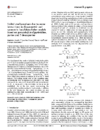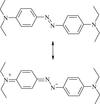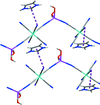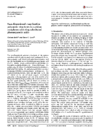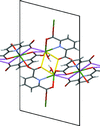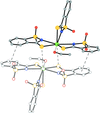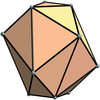issue contents
June 2014 issue

Cover illustration: The asymmetric unit of 2,2'-bi[benzo[b]thiophene], showing the two molecules in the unit cell. Displacement ellipsoids are drawn at the 50% probability level. See Cheung, Pennington, Bartberger & Staples [Acta Cryst. (2014), C70, 547-549].
research papers
Download citation


Download citation


Two Fe3(CO)8(μ3-S)2 clusters with terminal N-heterocyclic carbenes have been synthesized. Of the eight carbonyl ligands, one deviates significantly from linearity. In one cluster, N—H⋯S and C—H⋯O hydrogen bonds combine the molecules into [101] sheets, while in the other cluster, N—H⋯S and C—H⋯O interactions link the molecules into [111] chains.
Download citation


Download citation


The title structures have been redetermined in order to improve the structural data of the rhombohedral series of group 1 rare earth sulfides. The observed dependence of the fractional coordinate z(S2−) on the identity of the rare earth element in the newly determined structures is in agreement with the known structures of the potassium and rubidium analogues.
Download citation


Download citation


The molecular components of a solvated 7H-pyrimido[4,5-b][1,4]diazepine derivative are linked by hydrogen bonds to form sheets containing four types of hydrogen-bonded ring.
CCDC reference: 998427
Download citation


Download citation


Two new NiII complexes are presented, i.e. a one-dimensional polymeric complex incorporating homophthalate, where the anion acts as the bridging ligand, and a complex incorporating benzene-1,2,4,5-tetracarboxylate, with two independent Ni centres in different environments, one of them a centrosymmetric 4− dinuclear complex and the other a 2+ mononuclear unit, appearing in a 1:2 ratio. The supramolecular structure is supported by a profuse hydrogen-bonding network.
Download citation


Download citation


The cross-coupling reaction of (benzo[b]thiophen-2-yl)tributylstannane and 2-chloro-3-methylpyridine using a palladium catalyst gave the desired product in excellent yield, but resulted in the unexpected isolation of the benzo[b]thiophene dimer present in trace quantities (2–3 mol%) during recrystallization. Two independent half-molecules of this dimer comprise the symmetric unit, and the dimers exhibit ring disorder.
CCDC reference: 999625
Download citation


Download citation


A novel semiconducting quaternary mixed halogenide, Tl5Hg2Br5I4, represents a new series of composite structures described by the general formula nTlBr*mTl2[HgBr2I2].
CCDC reference: 1000657
Download citation


Download citation


Three butylidene-linker models have been designed and synthesized. They show intramolecular folding in solution and also, more importantly, in the solid state. These folded conformations in the solid are mainly stabilized by interactions between arene groups.
Download citation


Download citation


In the centrosymmetric dimeric fragment of the title compound, each BiIII centre is seven-coordinated by three O atoms and four N atoms in a distorted pentagonal–bipyramidal geometry. The three-dimensional supramolecular structure is assembled via O—H⋯O hydrogen bonds and two types of π–π stacking interactions.
CCDC reference: 1000571
Fully developed supramolecular aggregates HxOyz exhibit three modes of hydrogen bonding with characteristic contiguous O⋯O distances. These distances can be used to identify hydrate species and to guide H-atom placement.
Download citation


Download citation


The crystal and molecular structures of two para-substituted azobenzenes with π-electron-donating –NEt2 and π-electron-withdrawing –COOEt groups are reported, along with the effects of the substituents on the aromaticity of the benzene ring. Density functional theory (DFT) calculations were performed to analyse the differences in the geometry and aromaticity of the studied compounds in the crystalline state and for the isolated molecules.
Download citation


Download citation


For the structure of fluconazole monohydrate, a case study on different model refinements is reported, based on single-crystal X-ray diffraction data measured at 100 K with Cu Kα radiation to a resolution of sin θ/λ of 0.6 Å−1. The structure, anisotropic displacement parameters (ADPs) and figures of merit from the independent atom model are compared to `invariom' and `Hirshfeld atom' refinements.
Download citation


Download citation


The title compound has been synthesized by an ionothermal method. The compound not only exhibits a three-dimensional structure with a unique coordination mode of the sulfate anion, but also features the first example of a heptanuclear strontium(II) coordination polymer.
CCDC reference: 1000733
Download citation


Download citation


Crystals of biologically active potassium (2,3-dichlorophenyl)glucosinolate were obtained as a dual solvate, containing one methanol and one ethanol molecule of crystallization. The three-dimensional polymeric network consists of chains containing the potassium ions coordinated and bridged by sugar O atoms, which run parallel to the a axis and are further crosslinked through the sugar molecules.
Download citation


Download citation


The FeIIIS2N2O2 chromophore contains two O,N,S-donating dianionic 3-ethoxysalicylaldehyde 4-methylthiosemicarbazonate(2−) ligands in perpendicular planes, with the O and S atoms in cis positions and the N atoms in trans positions. The FeIII cation is in the low-spin state at 100 K.
CCDC reference: 996723
Download citation


Download citation


1H-Benzotriazole (BTAH) has been used for the first time as a ligand to construct a copper(I) coordination polymer, viz. [Cu(BTA)]n. [Cu2(BTA)2]2 secondary building units form a one-dimensional chain along the c axis.
CCDC reference: 1001666
Download citation


Download citation


In an organic–inorganic hybrid compound, neighbouring [Co(CN)6]3− anionic units are linked by Li+ cations through the cyanide groups in a trans mode, forming a one-dimensional zigzag chain structure extending along the c axis. A three-dimensional supramolecular network is formed through hydrogen-bonding interactions and is further stabilized by weak CN⋯π interactions between the cyanide groups and the imidazolium cations.
CCDC reference: 1003652
Download citation


Download citation


Two-dimensional coordination polymeric structures have been found in the Cs salts of the 4-fluoro-, 3-chloro-2-methyl- and 2,4-dichloro- ring-substituted phenoxyacetic acids. These complexes exhibit irregular CsO6 to CsO8 coordination geometries and, in the case of the (2,4-dichlorophenoxy)acetate analogue, provide an example of a CsO8Cl geometry involving a hydrogen bis(phenoxyacetate) ligand species.
Download citation


Download citation


The reaction of dipicolinic acid with strontium yields a three-dimensional coordination polymer consisting of two independent Sr centres, two independent dipicolinate ligands (one doubly deprotonated and the other singly deprotonated) and two water molecules. The dipicolinate ligands adopt μ3- and μ4-bridging modes, linking the alkaline earth metal centres into a three-dimensional coordination framework.
CCDC reference: 1000180
Download citation


Download citation


Hydrogen bonds link molecules of the title compound into tripartite sheets, with the hydrogen bonds in the central layer and the hydrocarbyl substituents on the exterior.
CCDC reference: 1004427
Download citation


Download citation


A quaternary intermetallic dicerium lithium/nickel disilicide, Ce2Li0.39Ni1.61Si2, is compared with parent binary AlB2 and RE–T–Si (RE = rare earth and T = transition metal) ternary phase compounds. The calculated electronic structure indicates metallic bonding is dominant within Ce2Li0.39Ni1.61Si2.
CCDC reference: 1004063
Download citation


Download citation


In an ethanol-solvated centrosymmetric dimer of bismuth(III) and thiosaccharinate, the Bi3+ cation is coordinated by three thiosaccharinate ligands, all of them acting as bidentate chelates through the N and exocyclic S atoms (in a κ2N,S mode). Centrosymmetric dimers result from the association of molecules via π–π interactions.
CCDC reference: 1002464
Download citation


Download citation


The Li complex of 1,3,5-triamino-1,3,5-trideoxy-cis-inositol (taci) crystallizes as a dication, [Li(Htaci)(taci)]2+, whereas the Na and K complexes are simple bis-complexes, viz. [Na(taci)2]+ and [K(taci)2]+. All three complexes were isolated as iodide salts, with the additional inclusion of two water molecules in the Li complex. Extended hydrogen bonding constitutes characteristic supramolecular patterns in the solid state.


 journal menu
journal menu















